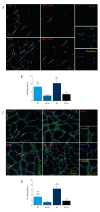Human Umbilical Cord Wharton's Jelly Derived Mesenchymal Stromal Cells May Attenuate Sarcopenia in Aged Mice Induced by Hindlimb Suspension
- PMID: 30571669
- PMCID: PMC6320659
- DOI: 10.12659/MSM.913362
Human Umbilical Cord Wharton's Jelly Derived Mesenchymal Stromal Cells May Attenuate Sarcopenia in Aged Mice Induced by Hindlimb Suspension
Abstract
BACKGROUND Since the use of human umbilical cord Wharton's Jelly derived mesenchymal stromal cells (hWJ-MSCs) to treat sarcopenia has not been explored, we studied the effects of hWJ-MSCs in aged male C57BL/6J mice with sarcopenia induced by hindlimb suspension, and explored the potential mechanism. MATERIAL AND METHODS Hindlimb suspension was used to induce sarcopenia in 24-month-old C57BL/6J mice and green fluorescent protein-tagged hWJ-MSCs and controls were transplanted into mice via tail vein or local intramuscular injection. After hWJ-MSC transplantation, changes in whole body muscle strength and endurance, gastrocnemius muscle weight and myofiber cross-sectional area (CSA) were studied. Proliferation of skeletal muscle stem cell, apoptosis, and chronic inflammation were also investigated. RESULTS We demonstrated that whole body muscle strength and endurance, gastrocnemius muscle mass, and CSA were significantly increased in hWJ-MSC-transplanted mice than in controls (P<0.05). In hWJ-MSC-transplanted mice, apoptotic myonuclei was reduced, and BrdU and Pax-7 expression indices of gastrocnemius muscles were increased (P<0.05). Tumor necrosis factor (TNF)-α and interleukin (IL)-6 were downregulated, and IL-4 and IL-10 were upregulated (P<0.05). CONCLUSIONS hWJ-MSCs may ameliorate sarcopenia in aged male C57BL/6J mice induced by hindlimb suspension, and this may be via activation of resident skeletal muscle satellite cells, reduction of apoptosis, and less chronic inflammation.
Figures






References
-
- Cruz-Jentoft AJ, Landi F, Topinková E, et al. Understanding sarcopenia as a geriatric syndrome. Curr Opin Clin Nutr Metab Care. 2010;13:1–7. - PubMed
-
- Bell KE, von Allmen MT, Devries MC, et al. Muscle disuse as a pivotal problem in sarcopenia-related muscle loss and dysfunction. J Frailty Aging. 2016;5:33–41. - PubMed
MeSH terms
LinkOut - more resources
Full Text Sources
Other Literature Sources

